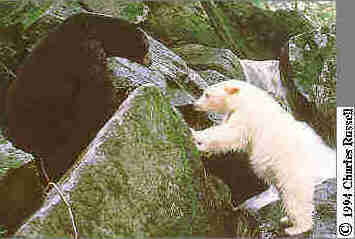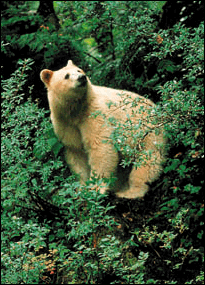|

| I can not significantly improve on the assertion that it simply is proper for us, as intelligent members of the universe, to try to look after our fellow creatures, and evil for us to do otherwise. |
Colin Tudge, 1992 Last Animals at the Zoo


Endangerment is everyone's problem, not just the scientist or the researcher. However, trying to understand how our natural world operates is not easy. We all need to know that a species that was formerly widespread, but is now limited to a few individuals living in isolated pockets, is most likely in crisis. Unless we can come up with a radical solution, these species will shortly disappear. The big question is, what do we need to do to stop these species from becoming extinct?
Through the efforts of many people all over the world, programs have been started to stabilize declining populations of species believed to be in imminent danger of extinction. In some cases, intervention and careful management have brought species back from the brink of extinction, like the Bald Eagle and the American Bison. In other cases, despite enormous investments of time, money, and expertise, some species, like the California Condor, remain perched on a razor's edge.
No one has all the answers to this problem of the extinction or endangerment of species. Each threatened species or habitat is a unique situation, demanding special attention and research. But there is reason to hope. If we can protect the natural areas where endangered species actually live, then there may be a future for the threatened species.
To give you an idea of how a species can become endangered, lets look at the Northern Spotted Owl. These owls live in an area that is considered one of the last remaining old-growth forests of North America, the forests of the Pacific Northwest. Old-growth means that the trees are more than 200 years old. They haven't been cut or altered by people. It is also one of the remaining primary habitats for these owls. They are very agile and feed principally on small mammals. The reason the Spotted Owl will roost in these old-growth forests is because it is cool and damp. It also has lots of holes in the old-growth trees where these owls can live. Also, the trees in the forest offer many rodents, which is the owls main source of food.
The wood from the trees in this old-growth forest is very fibrous and grainy. This makes it very valuable to the lumber companies, and has put the Spotted Owl in a very serious position. Eighty percent of these forests from Northern California to British Columbia have been cut down. This has caused a drastic loss of much of the habitat for these owls, and in 1990 they were listed as "Threatened." The problem that arose from listing this owl as "threatened" was to curtail logging; that is cutting down the trees in the forest. You now have a situation that causes the loss of jobs for the lumber companies to the survival of the owls. In reality it is not about this loss or the owls, but how to create an environment in balance with our economic needs and our natural resources.
In 1995, a proposed solution for this problem came from the US Fish and Wildlife Service (a federal agency that oversees the implementation of the Endangered Specis Act), and the Weyerhaeuser Company (a lumber company employing several hundred people in parts of Oregon affected by the listing). They agreed to a habitat conservation plan. Certain areas of the forest would be used to sustain groups of the Spotted Owls to maintain their survival, and Weyerhaeuser would have a different area of the forest to access the timber needed for their required production levels. It doesn't seem like a whole lot, but it certainly is a step in the right direction. One that will possibly maintain that vital balance we so need to protect species from eventually becoming extinct.
Information obtained from "Endangered! Exploring a World at Risk
Read more about the Northern Spotted Owl
 In the rainforest valleys and on a few rainforest shrouded islands on the British Columbia coastline, you'll find a white subspecies of black bear that scientists know as the Kermode bear. The inhabitants of this area call it the Spirit bear or ghost bear.
In the rainforest valleys and on a few rainforest shrouded islands on the British Columbia coastline, you'll find a white subspecies of black bear that scientists know as the Kermode bear. The inhabitants of this area call it the Spirit bear or ghost bear.
This wildlife treasure, as unique to our continent as the Panda is to China, is quickly losing its habitat. As with the Spotted Owl, Spirit Bear's habitat is the remaining areas of ancient trees, salmon runs and abundant wildlife that once stretched from California to Southern Alaska in the world's largest coastal temperate rainforest. You'll remember from the above story, that not much is left of this beautiful rainforest. As a matter of fact, the Southern part no longer exists. Spirit Bear has the same problem as the Spotted Owl: greedy timber companies devastating the forests.
While some considerations were made in the case of the Spotted Owl, where are the considerations for Spirit Bear? The logging interests with their massive machines are clear cutting their way across British Columbia at the rate of one acre every 66 seconds! "At this rate, timber companies will penetrate every untouched and unprotected watershed within the next ten years. One company is poised to clear-cut the Misty Islands and coastal valleys that are Spirit Bear's only home".
The legend of Spirit Bear is quite interesting. The native Kitasoo people say that when the great glaciers retreated northward, the Creator made Spirit Bear to remind the world that this lush rainforest was once white with snow. While the Creator proceeded to set aside an island for these "White Bear People," he made every 10th bear white! This is a real island called Princess Royal Island in British Columbia. It is the heart of a coastal wilderness and inhabited by this unique race of black and white bears. It is this island, along with the mainland rainforest valleys of Khutze, Aaltanhash, Green, and Carter that are in imminent danger. This is the "heart" of Spirit Bear wilderness.

Is there a solution? There certainly could be, and if a coalition of Canadian environmental groups led by the Valhalla Wilderness Society has anything to say about it, there will be. This group has asked the National Resources Defense Council in the US to help transform a potential ecological catastrophe (remember the greenhouse effect) into a worldwide model. Spirit Bear's home would be turned into the largest rainforest preserve in Canada, a 1,000 square mile park. The majority of jobs in this area are primarily dependent on salmon fishing, recreation and tourism. This park would only enhance the economy, making "Clearcutting" a dead end. (Click on the picture to learn even more about Spirit Bear).
Find out how you can help with letter writing or a donation by contacting NRDC, 40 West 20th Street, New York, NY 10011.
Information taken from the Jersey Shore Holistic Magazine, Spring Issue
Rainforest Facts
National Wildlife Federation
The Rarest Info Around
The Cub Den
All About Tigers
Defenders of Wildlife
Endangered Species Around the World
International Wildlife Coalition
VISIT SOME FUN PLACES
Amanda Ross' Endangered Species Fan Club
Animated Endangered Species Cards
The New Adventurers' Club
Hands on Children's Museum
Billy Bear's Playground
HOW TO HELP ENDANGERED SPECIES
Petition to Congress
Fax your Support (Canada)
How Students Can Help
Kid Can Help Tigers
page as a Starting Point Hot Site

That sure was interesting to read. I certainly learned a lot and I am sure you did, too. Now, would you like to see some great pictures of some of the endangered animals? You will also be able to learn more about each individual animal you see. So, click on the "Next" button and we will be on our way !!







You are visitor number

